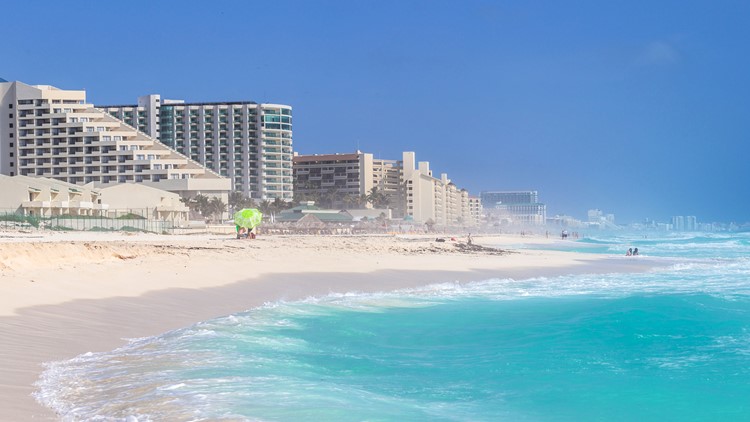CANCUN, Mexico — Anti-crime activist Teresa Carmona hangs embroidered sheets in a park with details of those killed in this tourist mecca. She started with eight sheets two years ago. Now she hangs up to 80 every Sunday and has 70 more stored at home.
"Most cases are not even investigated and go unpunished" because of indifference by authorities and residents, she said.
Violent crime is encroaching on this Riviera Maya tourist hot spot, as well as nearby Playa del Carmen and Tulum, jeopardizing a $20 billion a year business that attracts millions of visitors lured by the white sand beaches, archaeological ruins and pulsing nightlife.
Although the crime wave so far is mostly limited to areas outside the resorts where tourists stay, Cancun shows signs of following the ill-fated path of Acapulco. That city was once the granddaddy of Mexican tourist destinations, but now is one of country’s deadliest areas and no longer a mecca for international travelers.
Crime and violence between rival drug gangs has surged throughout Mexico, creeping into other popular destinations, such as Los Cabos on the southern tip of the Baja Peninsula. Homicides there are up 400% so far this year, underscored by the discovery of 14 bodies in a mass grave in June.
The spike in violence comes as Mexico welcomed a record 35 million foreign visitors in 2016, up nearly 9% from the previous year, according to the Tourism Secretariat.
Tourism officials acknowledge the problems plaguing tourist towns: low wages, inadequate housing for workers and increased crime, problems that recently prompted the Tourism Secretariat to announce plans to improve housing for tourism workers.
“A life like that creates the perfect situation so that many people turn to crime,” Tourism Secretary Enrique de la Madrid told Televisa. “We don’t just work to attract foreign tourists … but above all to improve local people’s quality of life.”
Quintana Roo state, where Cancun is located, recorded 133 murders in the first six months of 2017, more than double the total for all of last year.
In comparison, Chicago. which has the highest murder rate among big cities in the United States, recorded more than 400 homicides through July.
The violence in Cancun reflects a broader problem for Mexico, which is on pace this year for the most murders since 1997. The country listed 13,726 homicides between January and June, a 33% surge over the same period in 2016.
Mexico declared war on drug cartels and organized crime a decade ago, a conflict that claimed more than 200,000 lives and shows few signs of slowing up.
Security analysts pin the spiraling violence on fights over heroin production, which cartels have turned to as several U.S. states loosen their marijuana laws. Plus, when a cartel kingpin is killed or captured — such as Joaquín “El Chapo” Guzmán — fights for territory erupt and smaller criminal groups emerge to carry out kidnappings and extortion.
Five criminal groups operate in Quintana Roo, including the Sinaloa Cartel and the upstart Jalisco New Generation Cartel, according to a state report.
"Tourist security has been a constant priority for the authorities," said Daniel Flota Ocampo, director of Riviera Maya Tourist Promotion. He described the violence as "criminal groups settling scores among themselves" and said authorities are taking action against them.
"No tourists have been impacted," he said, adding that the region's occupancy rate is 90%.
Some local tourism workers object to suggestions that the state is unsafe for visitors. “People don’t talk about Florida and all the crazy stuff happening there, but they focus on Mexico when one or two things happen and it has nothing to do with tourism,” said Martha Mendez, who sells day trips for tourists to places such as the Maya ruins Chichén Itzá.
“If you’re not in that (criminal) circle, you’re fine,” she said.
Still, three men were gunned down in the Cancún hotel zone last November and the prosecutor’s office in the city was shot up a few months later. Five security guards died at an electronic music festival in Playa del Carmen in January, and a July shootout in a nightclub on the city's famed Fifth Avenue injured three. Gunmen shot a police commander outside his home in late July.
A June survey by state statistics institute INEGI found 79% of Cancún residents call the city “insecure,” up nearly six percentage points from December.
Tourists tend to stick to Cancún’s isolated all-inclusive resorts, minimizing the risk of encountering violence.
“It’s fine here. We’ve been taking the bus everywhere,” said George Marquez, a sign shop employee from San Antonio. “I wouldn’t say that about the (U.S.-Mexico) border region.”
“There are gangs everywhere. You have to be smart,” said DeJuan Muschamp, a bank employee from Belize. "I’ve had no issues. I didn’t get sick drinking the liquor,” he added, referring to a USA TODAY Network report about tourists falling ill after drinking what they believe to be adulterated liquor in Cancún clubs and resorts.
Local residents, meanwhile, live in shabby barrios that tourists seldom see.
“Everyone says we live in paradise. But there’s a heaven and hell here. Hell is the colonias” where people live, said Ildefonso Pool, an Uber driver and 37-year resident of Cancún. “This city brings in more money than any other in the country, and people live in a garbage dump.”
Cancún, with a current population 725,000, was a sparsely populated fishing outpost prior to 1970, when the Mexican government started construction to turn this part of the Yucatan Peninsula into a resort and tourism locale. Tourism was always the focus, never accommodating the hoards of impoverished workers arriving.
“Every mayor here talks as if they are the tourism secretary … and doesn’t plan for residents so that they can live with a little dignity,” said Celina Izquierdo, of the Social and Gender Violence Observatory, which monitors security issues. “Cancún never planned for growth or social development. It planned for tourism development."



